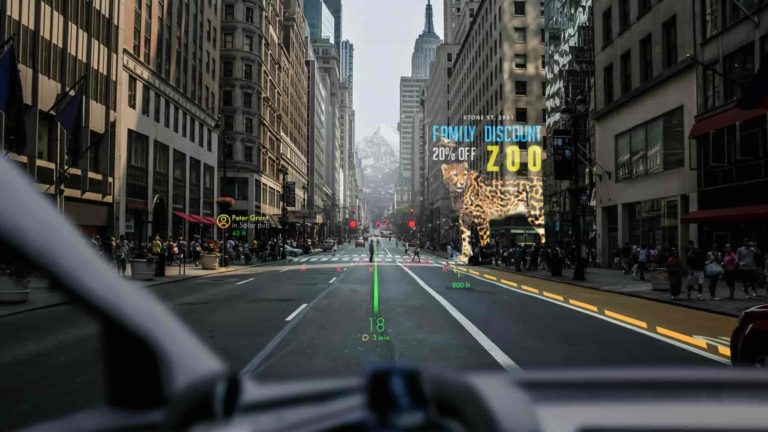
The metaverse continues to be a nebulous ball of hype and speculation. That sounds like a slam but it’s not – the metaverse follows patterns of past hype cycles as it tries to define itself. Like the web, it will eventually materialize in ways we’re not talking about today.
That said, signs today point to a few possible tracks. There’s the common connotation of synchronous 3D worlds like Fortnite. And there’s the less-discussed “real-world” metaverse. The latter involves infusing places and spaces around us with digital depth and dimension.
That second track is truer to the term metaverse, given that the Greek root meta means “beyond.” In that sense, AR content can enliven real-world places and objects, creating depth and meaning that goes beyond their physical state. We sometimes call this the metavearth.
This principle also relates to Living Cities, a startup led by AR veteran Matt Miesnieks, Foursquare co-founder Dennis Crowley and visual effects artist John Gaeta. The always-astute Miesnieks recently broke down its founding principles – the topic of this week’s XR Talks.
Location, Location, Location
Beyond the strength and star power in its founding team, Living Cities is driven by a few key principles. One is the economic principle of scarcity, which creates value. In that sense, reality is scarce. There’s only one Empire State Building, Eiffel Tower, and the place you were born.
Meanwhile, digital content is essentially infinite. Software has brought immense value to humanity (and businesses that harness it), in that its creation and delivery is a function of bits rather than atoms. This advantage can be seen in the P&L statement of any SaaS company.
Miesnieks believes there’s immense opportunity to marry these principles. Can software unlock value in physical places? This is something that co-founder Dennis Crowley set out to do with Foursquare in 2009 by harnessing new mobile capabilities (e.g., GPS) to engender geo-relevance.
Similar to that vision, which at the time relied on social dynamics and gamification, Miesnieks sees the value of the places around us as physical representations of meaning. It’s a matter of developing software – like Foursquare did – that taps into or surfaces that meaning.
Though the stealth company is light on details, signals point to something that could involve an AR Cloud-driven experience that relies on geo-anchored data to trigger digital experiences where and when relevant. That could be for social connection, local discovery, or gaming.
“Who we are is a function of the place we’re in,” said Miesnieks from the AWE stage.
Hard-Fought Lessons
Regardless of the company’s eventual product, equally valuable today are its principles. Here, Miesnieks applies hard-fought lessons from his career in AR, mixed in with the cross-disciplinary perspectives of his co-founders. The result is 9 principles that drive Living Cities.
Taking those one at a time, the principles are broken down below, including our take:
1. Reality is scarce: As noted, there’s scarcity in physical world places and things. Can that be enhanced and celebrated with digital content?
2. People are the killer app: Software should generally enable people to be productive, find each other, or be entertained… then get out of the way. Software that puts people at the center wins.
3. It’s all about the spirit of a place, not the geometry: AR cloud apps and “digital twins” focus on mapping physical contours. This is important but it’s more important to define the contextual significance of a given place.
4. Lore is built into location: Fiction has the burden of having to create lore and backstory. Physical places have that already baked in – sometimes with compelling historical or personal significance. Geo-local software companies should lean into this.
5. Communication, social & self-expression are the same thing: Related to the human-centric approach, communication by and between users is important. Living Cities will likely crowdsource its content in order to reach the massive scale of the inhabitable earth.
6. AR is the wrong place to start: At this stage of AR’s lifecycle, it should be a feature but not the centerpiece. It’s too early for mass adoption and business metrics to build an “AR” company. (Possible clue: perhaps geo-triggered audio content is in the cards a la Crowley’s “Marsbot”.)
7. Reality is dynamic and alive: Any successful geo-local experience can’t be static. Because the physical world is constantly changing, the UX has to do the same. This is an area where Foursquare excelled, and is another clue about a crowdsourced content approach.
8. Get in the metaverse in order to get off the metaverse: The metaverse as its currently discussed could be dystopian and isolating, as several people have pointed out. Its physical world counterpart could conversely make us more connected with the physical world.
9. The real and virtual are reflections of each other (not digital twins): Digital twins are all the rage in AR circles. But instead of things that are “twins,” geo-relevant digital experiences could be “siblings” in that they’re based on places but infused with imagination and narrative.
So there you have it. For more color from Miesnieks, check out the full talk below, and stay tuned for more product details from Living Cities in the coming months.

